Is there an Image Doctor in the House?
Alien Skin's Image Doctor 2 is designed to fix problems with images. In general, the plug-in for Photoshop and other applications that use the Photoshop standard accomplishes everything it claims to but advances made by Adobe in the built-in Photoshop features may contraindicate your employment of this doctor.
As with most Alien Skin applications, you'll start with a dual-screen before-after view (left-right, top-bottom, diagonal, or whole image) and the ability to view the full image, zoom in on part of the image, view at 100% enlargement, or enlarge beyond 100% to see fine details. You'll also have the ability to change each of the individual settings used by the specific filter that you select. Image Doctor offers the following:
- JPG repair
- Smart fill
- Dust & scratch remover (a variant of smart fill)
- Blemish concealer
- Skin softener
 Here's an old (pre 1990) low resolution JPG that I found on my hard drive. The first image here shows the factory default settings.
Here's an old (pre 1990) low resolution JPG that I found on my hard drive. The first image here shows the factory default settings.
Click a small image for a larger view. Click the larger view to close it.
 Here I've modified the deblocking and blur settings to improve the overall image. Old JPG images from cameras such as the (deservedly) much maligned Sony Mavica will never be good but the Image Doctor can make them less bad.
Here I've modified the deblocking and blur settings to improve the overall image. Old JPG images from cameras such as the (deservedly) much maligned Sony Mavica will never be good but the Image Doctor can make them less bad.
 The default settings for a low-quality image increase the deblocking value dramatically.
The default settings for a low-quality image increase the deblocking value dramatically.
 Here's the before image. Notice that it's a bit "crunchy".
Here's the before image. Notice that it's a bit "crunchy".
 The after image, although not as sharp, has lost the objectionable crunchiness that's apparent in the original.
The after image, although not as sharp, has lost the objectionable crunchiness that's apparent in the original.
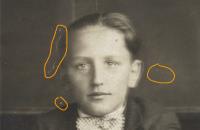 Here's a grade-school photo of my father-in-law. The image has several scratches and blemishes that I've circled in the image at the right.
Here's a grade-school photo of my father-in-law. The image has several scratches and blemishes that I've circled in the image at the right.
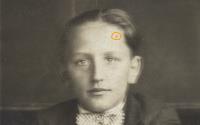 Image Doctor 2 has taken care of the 3 problems that I noted above and now I'd like it to remove one more mark.
Image Doctor 2 has taken care of the 3 problems that I noted above and now I'd like it to remove one more mark.
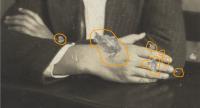 I have two copies of this image and the other copy doesn't have the physical damage shown here. Nonetheless, I thought it would be worthwhile to see what Image Doctor could do.
I have two copies of this image and the other copy doesn't have the physical damage shown here. Nonetheless, I thought it would be worthwhile to see what Image Doctor could do.
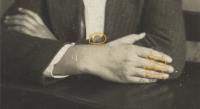 Remarkable! Yes, there are still some areas that would need additional attention, but this is an astonishing improvement over the original.
Remarkable! Yes, there are still some areas that would need additional attention, but this is an astonishing improvement over the original.
Here are some additional examples provided by Alien Skin:
 Although cleaning blemishes is something that Photoshop can accomplish on its own, Alien Skin's approach makes the process faster and easier. If you're a portrait photographer, this would be a very useful capability.
Although cleaning blemishes is something that Photoshop can accomplish on its own, Alien Skin's approach makes the process faster and easier. If you're a portrait photographer, this would be a very useful capability.
 When we look at people, we generally ignore the shine as seen in the left image. What we see is more like the image on the right. Alien Skin's Image Doctor does an outstanding job of controlling shine and glare.
When we look at people, we generally ignore the shine as seen in the left image. What we see is more like the image on the right. Alien Skin's Image Doctor does an outstanding job of controlling shine and glare.
 Mom loves the photo but hates the tat. A small operation by Image Doctor removes the tatoo. This could easily be achieved by Photoshop's Content-Aware Fill feature.
Mom loves the photo but hates the tat. A small operation by Image Doctor removes the tatoo. This could easily be achieved by Photoshop's Content-Aware Fill feature.
 Correcting scratches and dust spots is also something that Photoshop can accomplish on its own but Image Doctor does a good job.
Correcting scratches and dust spots is also something that Photoshop can accomplish on its own but Image Doctor does a good job.

 Some of Image Doctor's Features Are Overshadowed by Photoshop
Some of Image Doctor's Features Are Overshadowed by Photoshop
If you're using the current version (CS5.1) of Photoshop or even the previous CS4 version, Image Doctor brings little to the operating room unless you're a portrait photographer. But if you're still using an earlier version of Photoshop or a less-capable program such as Corel Photo-Paint, you'll add some impressive new features. It'll be interesting to see what Alien Skin Software does with Image Doctor 3.
For more information, visit the Alien Skin website.
Easy Website Mistakes to Avoid
I recently wrote an article called “How to Keep Website Visitors from Returning. Ever.” Although TechByter Worldwide isn't a website/podcast for website designers, it does reach a lot of people who create websites in the SOHO (small office/home office) market segment. So I thought that article might be of interest.
No single “right way” exists to design a website because every website is different and every website is designed to serve a different audience. But many ways exist to design a website badly. Consider these as ways to annoy visitors and ensure that they’ll never come back.
Nobody intentionally creates a bad website but it’s easy to do. The first rule to keep in mind is never to do something just because you can do something. If you’re running a humor site, people come to the site for humor; otherwise, they’re not looking for funny business. Think you can lie about something (or fib or obfuscate)? Think again. Maybe you’ll fool some people once but long-term relationships aren’t built on prevarications.
Here’s a short list of errors that are easy to make because they seemed like good ideas at the time. They’re guaranteed not to make friends or impress your visitors.
- Create a bloated site that takes 30 seconds to load. Various studies have suggested that website visitors will give your site 3 seconds or 8 seconds or 12 seconds (pick a number) to prove that it’s worth viewing. If, after 15 seconds, your site is still loading, you’re going to lose a lot of visitors.
 This site is from Yale University. Even worse, it's from Yale's art school. What is the site trying to communicate?
This site is from Yale University. Even worse, it's from Yale's art school. What is the site trying to communicate? - Force visitors to endure a 60-second Flash presentation. If you must create a Flash entry page (please don’t) at least give visitors the option to skip it.
- Autoplay music or video and make it replay every time the visitor returns to the home page. Maybe this was cool 15 years ago but it’s no longer cool. (Hint: It wasn’t cool 15 years ago either.) If you have a reason to offer audio or video, let the visitor choose to play it. And if you must play audio or video the first time a visitor arrives, at least set a cookie so that you won’t play it again when the same visitor lands on the home page a second time.
- Make the interface confusing. A site I recently visited included a list of projects and beside each project a symbol was displayed: Black pentagons, green triangles, red octagons, silver diamonds, brown squares, blue circles, and yellow stars. I had no idea what they meant and I tried to read some meaning into the shapes. As it turned out, the shapes were meaningless but the color of the shape was significant. The symbols were not explained by a key anywhere on the page.
- Create “mystery meat” navigation. That’s a term coined by Vincent Flanders, author of Websites that Suck. He’s referring specifically to unlabeled graphics that are used for navigation because the designer thought they were cool. People expect links to look like links. They expect navigation tools to have some explicit meaning. Don’t be clever.
 Do you have any idea what clicking anywhere on this site might do?
Do you have any idea what clicking anywhere on this site might do? - Force me to register before I can see more than the home page. If the information you have is something that I really want to see, I might register but I probably won’t give you my real name or any other accurate information. I might even be rude. You may have a newsletter that I would enjoy but let me decide to request it after wandering around the site.
- Show me a menu with 147 choices. More is not better. Focus! Create a menu that anyone can understand. Start with major choices (products, services, about, contact) and one level of options. If you need more than that, you need a different kind of navigation—one that allows visitors to search for what they’re seeking.
 The bear is a link. So is the glass with the spring. So is all the stuff in the lower left corner. I have no clue what to do so I'm leaving.
The bear is a link. So is the glass with the spring. So is all the stuff in the lower left corner. I have no clue what to do so I'm leaving. - Make the site cluttered. Headlines in blue. Yellow starbursts all over the page. Text in a dozen typefaces and sizes. A rainbow of colors. The goal is to communicate, not to overwhelm. If ever a case existed for the “less is more” school of thought, this is it. In the early days of desktop typesetting, this was referred to as ransom-note publishing.
- Omit contact information. If your site sells something, tell me who you are and where you are. I want a physical address (street, city, state, and postal code). Give me your phone number and your e-mail address, too. If you won’t tell me where you are, you won’t get my business. And don’t make this information hard to find. If you won’t put it on every page, at least provide a link to it from every page.
- Hide information about what I need to do if I want to return something. If your guarantees and return policies are obscure, I’m not going to buy from you. This is true of a lot of people. A 100% money-back guarantee is one of the strongest offers you can make. If you can, do; if you can’t, at least tell me what your terms are.
- Play games with security. If you tell me your site is secure, then I’d better see “https” in the address and my browser had better tell me that the connection is encrypted. If you display trust or security symbols (BBB and such) and the link is to a directory on your site, I’ll leave immediately and then I’ll contact the organization whose mark you’re misusing and report you for fraudulent use of their trademarks.
- When I make an error on your site’s form, don’t tell me what’s wrong. And while you’re at it, be sure to delete all of the information on the form so I’ll have to enter it again because I don’t have anything better to do. It’s easy to mis-key something on a form. When that happens and I have to spend a minute or more figuring out what’s wrong, I may go to your competitor’s site. If I make a mistake and you blank out all information on the form, I will go to a competitor’s website.
- Send me e-mail every day when I sign up for your newsletter. Unless you’re running a newspaper, there is no reason for you to contact me every day. Do that and I’ll unsubscribe before the end of the first week.
- Ignore my unsubscribe request. If I don’t want your e-mail any more, continuing to send it to me will not predispose me to use your product or service. When I tell you to stop, stop. If you don’t, I’ll block all messages from your domain and I may complain to your upstream service providers. Did you want that outcome?
- Make it impossible for me to search your site to find what I’m looking for. People visit websites for a reason. In many cases, that reason is to find something (product, service, information). If you make it impossible to find what the visitor is seeking, the visitor will leave.
- Pop up a live-chat window 10 seconds after I arrive at your site. No, I don’t want to chat with your sales representative. I’m not yet sure what you offer or whether I want to do business with you. Show a live-chat link if you want, but skip the pop-ups unless you want me to leave. And if you do offer a live-chat option, make sure that someone is really available. When I click the live-chat link and I’m told that I need to send an e-mail, I’ll go to your competitor’s website.
- Display a pop-up feedback survey the instant someone lands on your home page. I don’t yet know who you are, what you do, or why I might want to deal with you. Why would I be interested in filling out a survey?
- Make your website so wide that I have to scroll sideways to read it. Many people have wide screens these days but that doesn’t mean that they run their browser in a wide-screen mode.
- Ask me for far too much information. If I’m buying something, you’ll want my billing and shipping information (name and full address for each). You’ll want my payment information (credit card number, billing name, expiration date, and security number). And that’s it. You probably don’t need to know my sex (and please call it “sex” instead of “gender”). Unless I’m buying alcohol, cigarettes, or pornography, you don’t need my age. You also don’t need my marital status or the color of my favorite cat. Don’t be nosey.
- Make it impossible for me to change anything in the shopping cart. If I accidentally type “11” instead of “1”, don’t allow me to change the quantity without starting a new order. That will guarantee that I buy from someone else.
- Add fees on the final page. I’ve checked the quantity and price of items, provided billing and shipping information, filled out the payment form with my credit card information. The next screen you display casually mentions that shipping for my $35 order is $70. You will not make a sale. You will not make a friend. You will earn a complaint to the Better Business Bureau and your state’s consumer protection agency. Avoid this by being up-front with me.
- Don’t provide a way to retrieve my user name or password. My shopping cart has a $750 order but I can’t log in because I’ve forgotten my password. Give me an easy way to solve the problem or I’ll abandon the order.
It’s important to consider your website from the visitor’s perspective. In fact, doing so is the only way to ensure that you’ll get it right.
A Book, Everywhere
When I bought a Kindle from Amazon, I expected to use it for technical documentation but found that I was reading far more fiction and non-technical non-fiction on the device and that I used it only occasionally for technical documentation. Then I found that I needed a copy of Microsoft's Manual of Style for technical writers. My choices were to pay more than $100 for a copy of the out-of-print book or about $20 for a Kindle version. Easy decision. I can read the book on my Kindle, on my office computer, on the netbook I keep at the office, on my home desktop computer, or on a notebook computer. I can see now that my initial thought of using the Kindle for technical documentation was a good one but that it was only part of the equation.
Amazon has developed reader software that runs on Windows and Mac operating systems. Linux users can install the reader under WINE ("WINE is not an emulator") and the application runs on many other handheld devices such as those from Apple and Android.
What this means is that you can purchase a Kindle version of a reference book (usually the price is lower than the price for a paper book) and then install it on a Kindle, an office computer, an office netbook, a home desktop, and a notebook.
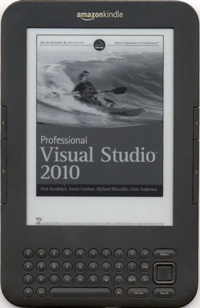 I've decided to learn more about Microsoft's Visual Studio 2010, which is a development platform for several languages (Visual Basic, C#, C++, F#, Visual Basic for Applications, and more.) In other words, this is not a trivial undertaking.
I've decided to learn more about Microsoft's Visual Studio 2010, which is a development platform for several languages (Visual Basic, C#, C++, F#, Visual Basic for Applications, and more.) In other words, this is not a trivial undertaking.
I decided to buy Professional Visual Studio 2010 as a Kindle book so that I can use it on my Kindle ...
 ... as well as on my office computer, an office netbook, my home desktop, and a notebook.
... as well as on my office computer, an office netbook, my home desktop, and a notebook.
If I'm really desperate, I'll be able to read the book on my Ipod Touch.
But I don't expect to be that desperate.
Trade Offs?
As an old curmudgeonly guy, I expect to prefer printed books and that's generally accurate. With a printed book, I can write notes to myself in the margin. I can flip instantly from the table of contents or index to the page that addresses my current interest. I can leave Post-It notes throughout the book. With the electronic version, I can do none of these.
But the electronic version makes it possible for me to have the book on a Kindle and on an office computer, an on an office netbook, and on my home desktop, and on and a notebook. The electronic version makes it possible for me to have access to the book wherever I am and without carrying around a gigantic, heavy book.
This is a generational thing.
My parents wouldn't have and (surprising to me) some members of my generation don't trust bank ATMs. A surprising number of people in my generation still won't pay bills, make purchases, or deal with their bank online. Printing a website to read it, although ecologically irresponsible, is something that I understand.
As much as I like paper copies of technical documentation, I'm now sold on the advantages of electronic manuals.
Short Circuits
Netflix Pushes Video Streaming
Netflix announced this week that prices are going up and that they're going down. Those of us who subscribe to the 2-DVD plan can have 2 physical DVDs at any time and unlimited streaming. It's probably no surprise that physical DVDs are a lot more expensive than streaming: The discs must be warehoused, picked, packed, shipped, received, unpacked, and returned to stock. Then the process repeats. Streaming eliminates discs, warehouses, and the people required to pick, pack, ship, and receive so you can guess what the company's long-term plans are.
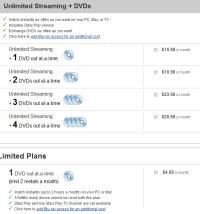 Netflix plans to separate unlimited DVDs by mail from unlimited streaming. The 2 DVD plan costs $15 per month and those who use that plan have two choices:
Netflix plans to separate unlimited DVDs by mail from unlimited streaming. The 2 DVD plan costs $15 per month and those who use that plan have two choices:
- Plan 1: Unlimited Streaming (no DVDs) for $7.99 a month
- Plan 2: Unlimited DVDs, 2 out at-a-time (no streaming) for $11.99 a month
The combined plans will be $20 per month, which is a pretty slick way to sock a 33% increase to your customers without telling them it's a 33% increase. "You don't need to do anything to continue your memberships for both unlimited streaming and unlimited DVDs," the message from Netflix says.
I rarely use the streaming service because I prefer the freedom of location provided by DVDs. For me, the decision to drop the streaming component is easy enough even though I use streaming once or twice a month.
The writing is on the screen, though. The cost of DVD-only plans will continue to increase until it reaches a point that some of us are unwilling to pay it. Then we'll switch to a streaming program that will probably continue to increase in price.
Isn't the future exciting?
Google+ Wants to be the New Facebook
Google+ (pronounced "Google Plus") is Google's version of Facebook. So far it doesn't amount to much and it will be interesting to see what users do with it. I became a member this week and already my younger daughter and a few acquaintances are there. MySpace was supplanted by Facebook. Will Facebook be supplanted by Google+?
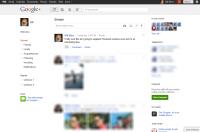 Here's my default Google+ page with photos from some people who have shared images with me (blurred for privacy).
Here's my default Google+ page with photos from some people who have shared images with me (blurred for privacy).
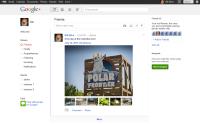 Here is a page where I have shared some images from the Columbus Zoo.
Here is a page where I have shared some images from the Columbus Zoo.
Karen Templer (who I don't know) wrote in a post that was linked by someone I do know, "In a lot of ways, I feel this is like the early days of Twitter -- a world still small enough that you can actually check out the profiles of new people you run across, or who've reshared or commented on your posts, and see if their posts are of interest. Of course, the hurdle is Circles. I might go to check out someone and see only an empty posts page, because they've shared everything with Circles I'm not a member of."
When Google releases something new, documentation is usually absent and that's the case with Google+. It's up to users to figure out how things work and maybe to figure out how things should work.
![]() Google+ is using the same model as G-mail in that you need to receive an invitation from a current user but there are no apparent restrictions on how many people a user may invite. So if you haven't already received 135 invitations from your closest friends and you'd like one, let me know.
Google+ is using the same model as G-mail in that you need to receive an invitation from a current user but there are no apparent restrictions on how many people a user may invite. So if you haven't already received 135 invitations from your closest friends and you'd like one, let me know.



 The author's image: It's that photo over at the right. This explains why TechByter Worldwide was never on television, doesn't it?
The author's image: It's that photo over at the right. This explains why TechByter Worldwide was never on television, doesn't it?
